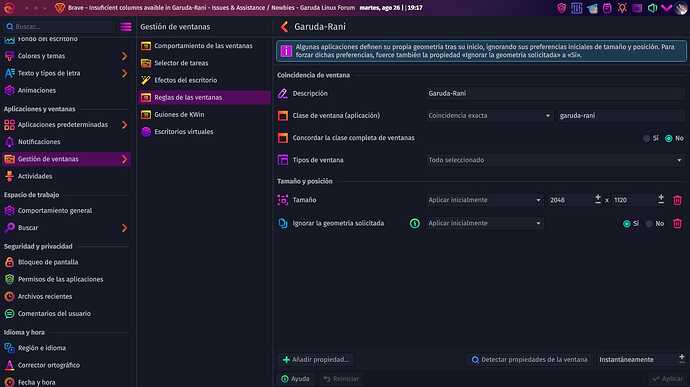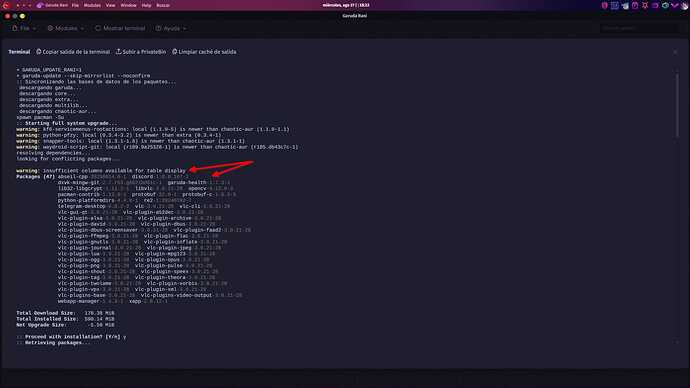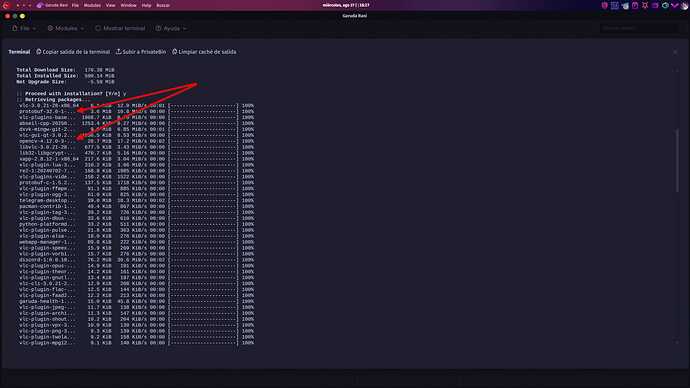Hi, when I update my system with garuda-rani, I always get the following warning:
searching for conflicting packages...
> Warning: nsufficient columns available for table display
Packages (20) edk2-ovmf-202505-1 garuda-common-settings-2.8.1-2
lib32-vulkan-intel-1:25.2.1-1lib32-vulkan-mesa-layers-1:25.2.1-1
lib32-vulkan-radeon-1:25.2.1-1 linux-zen-6.16.2.zen1-1linux-zen-headers-6.16.2.zen1-1
mesa-1:25.2.1-1 python-lxml-6.0.1-1qt6-declarative-6.9.1-3
samba-2:4.22.4-1smbclient-2:4.22.4-1 vulkan-intel-1:25.2.1-1
vulkan-mesa-layers-1:25.2.1-1 vulkan-radeon-1:25.2.1-1
vulkan-swrast-1:25.2.1-1
And I can’t see the version of the old package or the version of the update.
I’ve looked at these threads:
but I can’t find anyone else with the same problem, so I’ve put it aside, because I guess there’s something wrong with my configuration.
This doesn’t happen if I use garuda-update in the terminal.
My inxi:
System:
Kernel: 6.16.2-zen1-1-zen arch: x86_64 bits: 64 compiler: gcc v: 15.2.1
clocksource: tsc avail: hpet,acpi_pm
parameters: BOOT_IMAGE=/@/boot/vmlinuz-linux-zen
root=UUID=1b079d8b-58a3-4533-8245-22b97207f1e1 rw rootflags=subvol=@
pcie_aspm=off quiet loglevel=3
Desktop: KDE Plasma v: 6.4.4 tk: Qt v: N/A info: frameworks v: 6.17.0
wm: kwin_wayland vt: 1 dm: SDDM Distro: Garuda base: Arch Linux
Machine:
Type: Desktop System: Gigabyte product: Z390 AORUS PRO v: N/A
serial: <superuser required>
Mobo: Gigabyte model: Z390 AORUS PRO-CF serial: <superuser required>
uuid: <superuser required> UEFI: American Megatrends v: F14b
date: 06/12/2025
CPU:
Info: model: Intel Core i9-9900K bits: 64 type: MT MCP arch: Coffee Lake
gen: core 9 level: v3 note: check built: 2018 process: Intel 14nm family: 6
model-id: 0x9E (158) stepping: 0xD (13) microcode: 0x104
Topology: cpus: 1x dies: 1 clusters: 8 cores: 8 threads: 16 tpc: 2
smt: enabled cache: L1: 512 KiB desc: d-8x32 KiB; i-8x32 KiB L2: 2 MiB
desc: 8x256 KiB L3: 16 MiB desc: 1x16 MiB
Speed (MHz): avg: 800 min/max: 800/5000 scaling: driver: intel_pstate
governor: powersave cores: 1: 800 2: 800 3: 800 4: 800 5: 800 6: 800 7: 800
8: 800 9: 800 10: 800 11: 800 12: 800 13: 800 14: 800 15: 800 16: 800
bogomips: 115200
Flags: avx avx2 ht lm nx pae sse sse2 sse3 sse4_1 sse4_2 ssse3 vmx
Vulnerabilities: <filter>
Graphics:
Device-1: NVIDIA TU104 [GeForce RTX 2080 SUPER] vendor: Gigabyte
driver: nvidia v: 580.76.05 alternate: nouveau,nvidia_drm
non-free: 550-570.xx+ status: current (as of 2025-04; EOL~2026-12-xx)
arch: Turing code: TUxxx process: TSMC 12nm FF built: 2018-2022 pcie:
gen: 3 speed: 8 GT/s lanes: 16 ports: active: none off: DP-2,DP-3
empty: DP-1,HDMI-A-1,Unknown-2 bus-ID: 01:00.0 chip-ID: 10de:1e81
class-ID: 0300
Display: wayland server: X.org v: 1.21.1.18 with: Xwayland v: 24.1.8
compositor: kwin_wayland driver: X: loaded: nvidia
unloaded: modesetting,nouveau alternate: fbdev,nv,vesa
gpu: nv_platform,nvidia,nvidia-nvswitch d-rect: 3926x2208 display-ID: 0
Monitor-1: DP-2 pos: top-right model: Asus ROG PG279Q serial: <filter>
built: 2017 res: mode: 2560x1440 hz: 120 scale: 125% (1.25) to: 2048x1152
dpi: 109 gamma: 1.2 size: 598x336mm (23.54x13.23") diag: 686mm (27")
ratio: 16:9 modes: max: 2560x1440 min: 640x480
Monitor-2: DP-3 pos: bottom-l model: Philips 191EL serial: <filter>
built: 2010 res: mode: 1366x768 hz: 60 scale: 100% (1) dpi: 85 gamma: 1.2
size: 410x230mm (16.14x9.06") diag: 470mm (18.5") ratio: 16:9 modes:
max: 1366x768 min: 640x480
API: EGL v: 1.5 hw: drv: nvidia platforms: device: 0 drv: nvidia device: 2
drv: swrast gbm: drv: nvidia surfaceless: drv: nvidia wayland: drv: nvidia
x11: drv: nvidia inactive: device-1
API: OpenGL v: 4.6.0 compat-v: 4.5 vendor: nvidia mesa v: 580.76.05
glx-v: 1.4 direct-render: yes renderer: NVIDIA GeForce RTX 2080
SUPER/PCIe/SSE2 memory: 7.81 GiB display-ID: :1.0
API: Vulkan v: 1.4.321 layers: 16 device: 0 type: discrete-gpu name: NVIDIA
GeForce RTX 2080 SUPER driver: nvidia v: 580.76.05 device-ID: 10de:1e81
surfaces: N/A device: 1 type: cpu name: llvmpipe (LLVM 20.1.8 256 bits)
driver: mesa llvmpipe v: 25.2.1-arch1.1 (LLVM 20.1.8)
device-ID: 10005:0000 surfaces: N/A
Info: Tools: api: clinfo, eglinfo, glxinfo, vulkaninfo
de: kscreen-console,kscreen-doctor gpu: corectrl, nvidia-settings,
nvidia-smi wl: wayland-info x11: xdpyinfo, xprop, xrandr
Audio:
Device-1: NVIDIA TU104 HD Audio vendor: Gigabyte driver: snd_hda_intel
v: kernel pcie: gen: 3 speed: 8 GT/s lanes: 16 bus-ID: 01:00.1
chip-ID: 10de:10f8 class-ID: 0403
Device-2: Creative Labs CA0132 Sound Core3D [Sound Blaster Recon3D /
Z-Series BlasterX AE-5 Plus] driver: snd_hda_intel v: kernel pcie: gen: 1
speed: 2.5 GT/s lanes: 1 bus-ID: 04:00.0 chip-ID: 1102:0012 class-ID: 0403
API: ALSA v: k6.16.2-zen1-1-zen status: kernel-api with: aoss
type: oss-emulator tools: N/A
Server-1: PipeWire v: 1.4.7 status: active with: 1: pipewire-pulse
status: active 2: wireplumber status: active 3: pipewire-alsa type: plugin
4: pw-jack type: plugin tools: pactl,pw-cat,pw-cli,wpctl
Network:
Device-1: Intel Ethernet I219-V vendor: Gigabyte driver: e1000e v: kernel
port: N/A bus-ID: 00:1f.6 chip-ID: 8086:15bc class-ID: 0200
IF: eno1 state: up speed: 1000 Mbps duplex: full mac: <filter>
Info: services: NetworkManager, smbd, systemd-timesyncd
Drives:
Local Storage: total: 3.18 TiB used: 1.48 TiB (46.3%)
SMART Message: Unable to run smartctl. Root privileges required.
ID-1: /dev/nvme0n1 maj-min: 259:0 vendor: Crucial model: CT1000P5SSD8
size: 931.51 GiB block-size: physical: 512 B logical: 512 B speed: 31.6 Gb/s
lanes: 4 tech: SSD serial: <filter> fw-rev: P4CR313 temp: 43.9 C
scheme: GPT
ID-2: /dev/sda maj-min: 8:0 vendor: Crucial model: CT500MX500SSD1
size: 465.76 GiB block-size: physical: 512 B logical: 512 B speed: 6.0 Gb/s
tech: SSD serial: <filter> fw-rev: 023 scheme: GPT
ID-3: /dev/sdb maj-min: 8:16 vendor: Seagate model: ST2000DM001-1CH164
size: 1.82 TiB block-size: physical: 4096 B logical: 512 B speed: 6.0 Gb/s
tech: HDD rpm: 7200 serial: <filter> fw-rev: CC27 scheme: MBR
Partition:
ID-1: / raw-size: 465.46 GiB size: 465.46 GiB (100.00%)
used: 243.28 GiB (52.3%) fs: btrfs dev: /dev/sda2 maj-min: 8:2
ID-2: /boot/efi raw-size: 300 MiB size: 299.4 MiB (99.80%)
used: 612 KiB (0.2%) fs: vfat dev: /dev/sda1 maj-min: 8:1
ID-3: /home raw-size: 465.46 GiB size: 465.46 GiB (100.00%)
used: 243.28 GiB (52.3%) fs: btrfs dev: /dev/sda2 maj-min: 8:2
ID-4: /var/log raw-size: 465.46 GiB size: 465.46 GiB (100.00%)
used: 243.28 GiB (52.3%) fs: btrfs dev: /dev/sda2 maj-min: 8:2
ID-5: /var/tmp raw-size: 465.46 GiB size: 465.46 GiB (100.00%)
used: 243.28 GiB (52.3%) fs: btrfs dev: /dev/sda2 maj-min: 8:2
Swap:
Kernel: swappiness: 133 (default 60) cache-pressure: 100 (default) zswap: no
ID-1: swap-1 type: zram size: 62.72 GiB used: 0 KiB (0.0%) priority: 100
comp: zstd avail: lzo-rle,lzo,lz4,lz4hc,deflate,842 dev: /dev/zram0
Sensors:
System Temperatures: cpu: 39.0 C pch: 54.0 C mobo: 35.0 C
Fan Speeds (rpm): cpu: 0 fan-2: 0 fan-3: 0
Power: 12v: N/A 5v: N/A 3.3v: 3.36 vbat: 3.07
Info:
Memory: total: 64 GiB note: est. available: 62.72 GiB used: 5.6 GiB (8.9%)
Processes: 412 Power: uptime: 56m states: freeze,mem,disk suspend: deep
avail: s2idle wakeups: 0 hibernate: platform avail: shutdown, reboot,
suspend, test_resume image: 25.02 GiB services: org_kde_powerdevil,
power-profiles-daemon, upowerd Init: systemd v: 257 default: graphical
tool: systemctl
Packages: pm: pacman pkgs: 1940 libs: 568 tools: octopi,pacseek,pamac,paru
Compilers: gcc: 15.2.1 Shell: Bash v: 5.3.3 default: fish v: 4.0.2
running-in: konsole inxi: 3.3.38
Garuda (2.8.1-2):
System install date: 2024-08-17
Last full system update: 2025-08-22
Is partially upgraded: No
Relevant software: snapper NetworkManager dracut
Windows dual boot: Probably (Run as root to verify)
Failed units: run-media-MULTIMEDIA.mount
--- System Health Check Report ---
22/23 checks run in 0.45 seconds ⌛
Powered by garuda-health 🦅
--- LOW ---
- Failed systemd services found: run-media-MULTIMEDIA.mount


